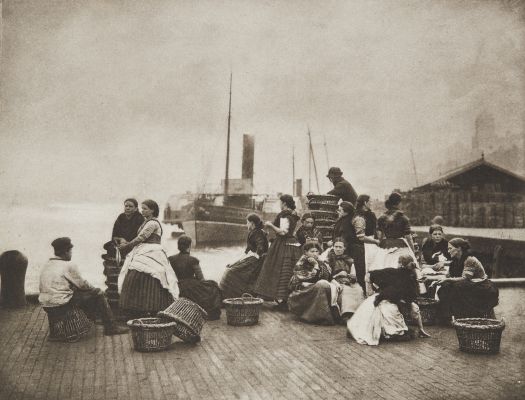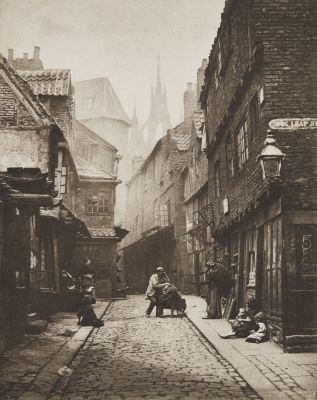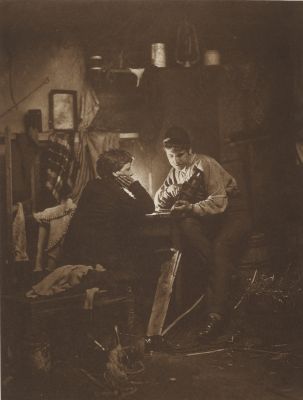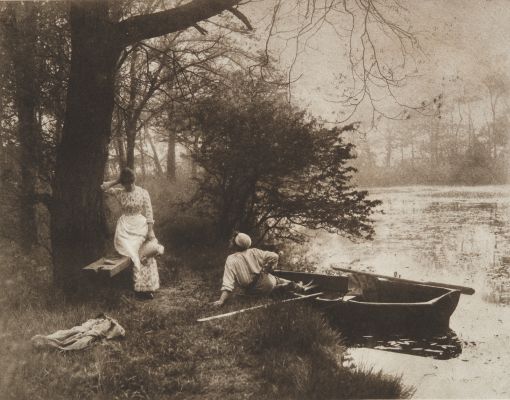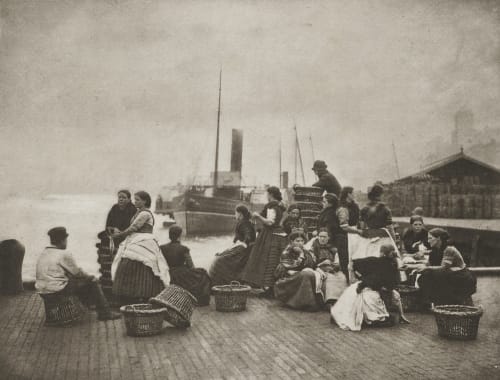
Title
Waiting For The BoatsArtist
Sawyer, Lyddell (British, 1856-1927)Publication
Sun Artists Number 4Date
1891Process
PhotogravureAtelier
Annan & SwanImage Size
13.6 x 18 cm
“I was born in photography, nursed in it, and have been continually “soaked” in it ever since. Lyddell Sawyer
The reproductions of Mr. Sawyer’s pictures… show clearly enough that for him there is poetry to be found in scenes of daily toil and care… phases of life which bear upon them the stamp of humanity… the same humanity which by an invisible bond links every mortal with every other mortal, and makes us today a part of and concerned in the history of all time. [1]
While British photographer Lyddell Sawyer (1856-1927) was highly acclaimed at the end of the 19th century, today he is all but forgotten. Sawyer, a founding member of the Linked Ring, produced masterful images, often sophisticated staged tableaux, representing captured moments of everyday scenes. This “faultless” image according to Margret Hawker is no exception. Today very few of Sawyer’s images survive. It is thanks to photogravure, that his legacy and work will endure.
Sun Artists was the first publication in England to represent ‘the artistic position of photography’. Published in eight parts between October 1889 and July 1891, each issue was devoted to the work of a single British photographer and illustrated by four hand-pulled photogravures. Particular care was taken by the publisher of Sun Artists to identify the individuals who prepared the photogravures for publication, all leading exponents of photogravure at the time. Mr Dawson of the Typographic Etching Company, himself an acclaimed photographer, made the etchings for Issue 1. Mr Cameron Swan of Messrs Annan and Swan made those for Issues 2, 3, and 4 while the etchings for Issues 5-8 were made by Mr W.L. Colls. [2]
These exceptional issues highlight those men and women who best express the period’s rich Pictorialist dialogue between painting and photography, the rise of the Secession Movement, and a turning point "in the ways photographs were made for the pages of books" [3] – namely in the photogravure process of "printing photographs from an etched copper plate" -as seen in these 32 superb hand-pulled gravures.
The photographers included are: J. Gale (essay by (George Davison); H.P. Robinson (essay by Andrew Pringle); J.B.B. Wellington (essay by Graham Balfour); Lydell Sawyer (essay by Rev. F.C. Lambert); Julia M. Cameron (essay by P.H. Emerson); B. Gay Wilkinson (essay by Rev. F.C. Lambert); F.W.H. Myers (essay by John Addington Symonds); and Frank Sutcliffe (essay by Charles N. Armfield). Sun Artists was issued in two states, a regular edition and an edition of 100 numbered copies on India proof paper, with the photogravures signed in pencil by the artists, with the exception of Julia Margaret Cameron who had already died.
Reproduced / Exhibited
Harker, Margaret F. The Linked Ring: The Secession Movement in Photography in Britain, 1892-1910. London: Heinemann, 1979. pl 6.9
Falconer, John, and Louise Hide. Points of View: Capturing the 19th Century in Photographs. London: British Library, 2009. p. 159.
References
[1] Descriptive text by F C Lambert
[2] Hannavy John. 2008. Encyclopedia of Nineteenth-Century Photography. New York NY: Routledge.
[3] Goldschmidt Lucien Weston J Naef and Grolier Club. 1980. The Truthful Lens : A Survey of the Photographically Illustrated Book 1844-1914. 1st ed. New York: Grolier Club no 41
McCaully – History of Photography "Writing Photography’s History before Newhall " v 21 n 2 1997
Harker, Margaret. The Linked Ring: the Secession Movement in Photography in Britain, 1892-1910. London: Heinemann, 1979. Print.
Gernsheim, Helmut. The History of Photography: The Age of Collodion. London: Thames and Hudson, 1989. p.44
Weaver, Mike. British Photography in the Nineteenth Century: The Fine Art Tradition. Cambridge [United States: University Press, 1989. p. 157-8

